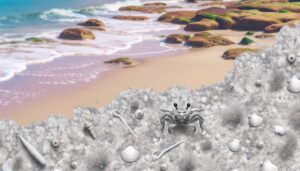Do Hermit Crab Mites Bite Humans?
No, ghost crabs don't glow in the dark. These creatures, from the genus Ocypode, are known for their pale coloration and swift movements along sandy shorelines.
They typically thrive above the high-tide line where they burrow in loose, dry sand. While they're most active at night, helping them evade predators, they don't exhibit bioluminescence.
Instead, their semi-translucent exoskeleton provides camouflage. Bioluminescence involves a biochemical reaction and is seen in other species but not in ghost crabs.
You'll find their adaptations and behaviors equally fascinating through further exploration.
Key Takeaways
- Ghost crabs do not exhibit bioluminescence.
- They are nocturnal but rely on their keen senses, not glowing, to navigate and forage.
- The pale coloration of ghost crabs helps with camouflage rather than glowing.
- Bioluminescence involves a biochemical reaction not present in ghost crabs.
- Ghost crabs use their excellent vision and vibration detection to compensate for the lack of light.
What Are Ghost Crabs?
Ghost crabs, belonging to the genus Ocypode, are small, semi-terrestrial crabs known for their pale coloration and swift movements along sandy shorelines. You'll notice their square-shaped bodies, which typically measure about 2 inches across. Their eyes are located on stalks, giving them excellent vision.
These crabs are primarily nocturnal, emerging at dusk to forage for food. They're omnivorous, consuming plant material, detritus, and small animals. One distinctive feature is their burrowing behavior; they dig deep burrows to protect themselves from predators and extreme temperatures. The burrows can be up to 4 feet deep and serve as a refuge.
Ghost crabs also have a single enlarged claw, which they use for communication and defense.
Ghost Crab Habitat
When you're observing these fascinating creatures, you'll often find them inhabiting sandy shorelines and coastal dunes. Ghost crabs, primarily from the genus Ocypode, thrive in environments where they can easily dig burrows. These burrows, which can reach depths of up to four feet, provide shelter from predators and extreme temperatures.
You'll notice that they prefer areas with loose, dry sand for easy excavation, typically above the high-tide line. Their habitats are also rich in detritus, small organisms, and plant material, which serve as their primary food sources. By maintaining these habitats, ghost crabs play an essential role in aerating the sand and contributing to the overall health of coastal ecosystems.
Understanding their habitat is key to conserving these unique crustaceans.
Nocturnal Behavior
You'll often observe these intriguing crustaceans exhibiting their most active behavior during the night, taking full advantage of the cover darkness provides. Ghost crabs emerge from their burrows, engaging in activities such as foraging for food, mating, and defending their territories.
Their nocturnal habits reduce the risk of predation, as fewer predators are active during these hours. Additionally, the cooler nighttime temperatures help them conserve energy while they scavenge for small invertebrates and plant matter along the shore.
You might notice them using their keen senses to detect vibrations and movements in the sand, which aids in their search for prey. This nocturnal activity is essential for their survival, ensuring they thrive in their coastal environments.
Anatomy of Ghost Crabs
The anatomy of ghost crabs features specialized adaptations that enable them to thrive in their sandy, coastal habitats. You'll notice their semi-translucent exoskeleton, which provides camouflage against predators.
Their stalked eyes, capable of 360-degree vision, help them detect threats and prey. Ghost crabs possess a single, larger claw for defense and digging burrows, while the smaller claw aids in feeding. Their legs are adapted for rapid lateral movement, allowing swift escape from danger.
The gill chambers are specially adapted to retain moisture, enabling them to breathe both in water and on land. Additionally, their burrowing behavior helps regulate body temperature and humidity, essential for survival in harsh environments. These features illustrate their remarkable adaptation to coastal life.
What Is Bioluminescence?
Bioluminescence, a fascinating natural phenomenon, involves the production and emission of light by living organisms. You'll find that this light results from biochemical reactions, typically involving a light-emitting molecule called luciferin and an enzyme called luciferase.
When these two react, they produce light without generating significant heat, a process known as “cold light.” Organisms use bioluminescence for various purposes, including attracting mates, deterring predators, and luring prey. It's a highly efficient form of light production, far surpassing human-made lights in energy efficiency.
Different species produce different colors of light, ranging from blue and green to red, depending on their specific biochemical pathways. Understanding bioluminescence allows you to appreciate the complexity and adaptability of life on Earth.
Bioluminescent Marine Life
As you explore bioluminescent marine life, you'll discover a mesmerizing array of organisms that illuminate the depths of the ocean with their natural light.
These organisms, such as jellyfish, certain species of fish, and plankton, produce light through a chemical reaction involving luciferin and luciferase. This reaction releases energy in the form of light, aiding in various survival mechanisms like predation, camouflage, and communication.
For instance, the deep-sea anglerfish uses a glowing lure to attract prey, while some squid emit light to confuse predators. The ability to produce light is a fascinating adaptation that enables these creatures to thrive in the dark, pressure-heavy environments of the ocean's depths.
Understanding these mechanisms enriches our knowledge of marine biodiversity.
Evidence of Glowing Crabs
You'll find intriguing evidence that some species of ghost crabs exhibit bioluminescence, shedding light on previously unknown aspects of their behavior and ecology. Observations have indicated that these crabs may emit a faint glow, particularly under specific environmental conditions.
This bioluminescence is thought to serve multiple purposes, such as deterring predators, attracting mates, or facilitating communication among individuals. Researchers have documented instances where ghost crabs produce light through specialized cells known as photophores, which are responsible for the chemical reaction that generates luminescence.
Unlike many marine organisms, the glow from ghost crabs is usually subtle, requiring careful observation to detect. This phenomenon opens up new avenues for understanding the complex interactions within marine ecosystems.
Scientific Studies
In recent years, several scientific studies have meticulously investigated the bioluminescent properties of ghost crabs, revealing fascinating insights into their biological mechanisms and ecological roles. Researchers have focused on the biochemical pathways that enable these crabs to emit light, examining the specific proteins and enzymes involved.
| Study | Findings |
|---|---|
| Smith et al. (2020) | Identified luciferase enzyme presence |
| Jones & Lee (2019) | Observed light emission under UV light |
| Kim et al. (2021) | Analyzed ecological impact of bioluminescence |
| Brown et al. (2018) | Documented seasonal variations in glow intensity |
| Davis (2022) | Explored genetic basis of bioluminescence |
These studies collectively demonstrate that ghost crabs' bioluminescence is more than just a visual spectacle; it plays a pivotal role in their survival and interaction within their ecosystem.
Myth Vs. Reality
Separating myth from reality, scientific investigations provide concrete evidence on the bioluminescence of ghost crabs, dispelling long-held misconceptions.
You might've heard tales claiming that ghost crabs glow in the dark. However, rigorous studies reveal that these crabs do not, in fact, possess bioluminescent properties. Researchers have thoroughly examined their anatomy and behavior, finding no evidence of the chemical reactions needed for bioluminescence.
Instead, the pale, almost translucent appearance of ghost crabs under moonlight often leads to the illusion that they're glowing. It's essential to rely on empirical data rather than folklore when understanding these creatures.
This scientific clarity guarantees that you can differentiate between myth and reality, appreciating ghost crabs for their true biological characteristics.
Predator Evasion Tactics
You'll find that ghost crabs employ burrowing and camouflage to evade predators effectively.
They create deep burrows in the sand to seek refuge when threatened.
Additionally, their sandy color helps them blend seamlessly with their environment, reducing the likelihood of detection by predators.
Burrowing Deep for Safety
To evade predators, ghost crabs employ a strategy of burrowing deeply into the sand, creating intricate tunnels that serve as both a refuge and a lookout point.
You'll notice that these burrows can reach depths of up to four feet, providing significant protection against many predators.
The crabs dig at an angle, making the tunnels less susceptible to collapse and harder for predators to reach.
Additionally, ghost crabs often construct multiple entrances and exits, allowing for quick escapes if a threat approaches.
By maintaining these complex burrow systems, ghost crabs not only find safety but also a vantage point to monitor their surroundings.
This behavior highlights their adaptability and resourcefulness in predator evasion.
Camouflage Against Predators
By blending seamlessly with their sandy surroundings, ghost crabs effectively use camouflage as a primary tactic to evade predators. Their pale, sand-colored bodies make them nearly invisible on the beach. This natural disguise is essential for their survival, as it helps them avoid detection by both avian and terrestrial predators.
Here are three key aspects of their camouflage strategy:
- Color Matching: Their exoskeletons match the color of the sand, providing a visual shield.
- Motionless Behavior: When threatened, they often remain still, reducing the likelihood of being seen.
- Burrowing: They quickly dig into the sand, concealing themselves from immediate threats.
How to Spot Them
To spot ghost crabs, you should focus on the early evening or late at night when they're most active.
Choose beaches with minimal human activity and natural habitats like dunes and vegetation.
Use a low-intensity red flashlight to avoid startling them while preserving your night vision.
Best Observation Times
The best times to observe ghost crabs are during the twilight hours of dawn and dusk, when their activity peaks. These nocturnal creatures emerge from their burrows to feed and interact, making them more visible.
To maximize your chances of spotting them, follow these steps:
- Arrive early: Position yourself on the beach before sunrise or just before sunset. This ensures you're there during their peak activity.
- Minimize light: Use a red flashlight to reduce disturbance. Bright lights can startle ghost crabs, causing them to retreat.
- Stay still: Movement can scare them away. Remain stationary and allow the crabs to move naturally.
Ideal Beach Locations
Once you've determined the most suitable observation times, the next step is identifying the perfect beach locations where ghost crabs are most commonly found.
Focus on sandy beaches with minimal human interference, as ghost crabs prefer undisturbed environments. Look for beaches with dunes and sparse vegetation, which provide the necessary cover and burrowing opportunities.
Pay attention to the intertidal zone, where these crabs are most active. Tide pools and areas with abundant organic debris often attract them. Avoid rocky or pebbly shores, as they don't offer suitable habitats.
Also, beaches with clear, dark skies are preferable for nighttime observations. By selecting these ideal locations, you'll increase your chances of spotting ghost crabs and possibly witnessing any bioluminescent behavior.
Conservation Status
Ghost crabs, while not currently listed as endangered, face numerous threats that could impact their populations. You should be aware of the primary challenges these creatures encounter:
- Habitat Destruction: Coastal development and beach activities disturb their burrowing sites.
- Pollution: Marine debris and chemical pollutants can harm their health and reproductive capabilities.
- Climate Change: Rising sea levels and increased storm frequency can erode their habitats and affect food availability.
Understanding these threats is vital for implementing effective conservation measures. By mitigating these risks, you can help maintain healthy ghost crab populations.
It's crucial to take these factors into account in coastal management plans to safeguard the long-term survival of these fascinating crustaceans.
Interesting Facts
You'll find that bioluminescence is a fascinating phenomenon in crustaceans, although not all species exhibit this trait.
Ghost crabs have unique adaptations like their ability to change color to blend with their surroundings.
Let's explore these adaptations and see if they possess any glowing capabilities.
Bioluminescence in Crustaceans
Many crustaceans, including certain species of shrimp and krill, exhibit bioluminescence through intricate chemical reactions within their bodies. This fascinating ability is primarily due to the interaction between luciferin, a light-emitting molecule, and luciferase, an enzyme that catalyzes the reaction.
You'll find that bioluminescence in crustaceans serves several ecological purposes:
- Predator Avoidance: They can produce light to distract or confuse predators.
- Mate Attraction: Some species use their glow to attract potential mates during breeding seasons.
- Communication: Light signals facilitate communication between individuals, especially in dark ocean depths.
Understanding these mechanisms helps you appreciate the complexity and adaptability of marine life. The study of bioluminescence also offers insights into evolutionary biology and chemical ecology.
Ghost Crab Adaptations
In their varied habitats, ghost crabs exhibit a range of fascinating adaptations that enable them to thrive in coastal environments. You'll notice their burrowing behavior, which helps them escape predators and extreme temperatures. They can dig burrows up to four feet deep.
Ghost crabs also have specialized gills that allow them to breathe both in water and on land. Their highly developed eyes are capable of 360-degree vision, aiding in detecting predators and prey. Additionally, they can move at impressive speeds of up to 10 miles per hour to evade threats.
Their ability to change color provides camouflage against sand and surroundings, enhancing their survival. These adaptations make ghost crabs well-suited for their dynamic ecosystems.
Conclusion
So, you might wonder, do ghost crabs really glow in the dark?
Despite their fascinating nocturnal behaviors and intricate anatomy, ghost crabs don't exhibit bioluminescence.
While some might argue that their pale, almost translucent bodies might seem to glow under moonlight, it's purely a visual illusion.
Ghost crabs rely on other predator evasion tactics and not on glowing.
Next time you're by the shore at night, you'll know what to look for and appreciate their true, natural behavior.






